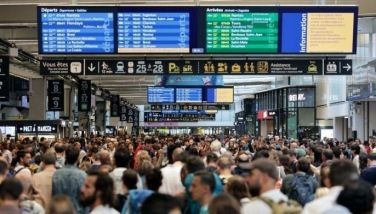The story of Undas

For Catholics, the proper day to visit their deceased loved ones in the cemeteries is actually on Nov. 2, which is All Souls Day. This is the appropriate day for mourning the dead. There should be no parties or merrymaking on this day. But most Filipinos visit the cemeteries on Nov. 1, All Saints Day. However, this is supposed to be one of the happiest feast days of the Church because it celebrates the Feast of All Saints.
Let me share a short but interesting article on how this Filipino custom was celebrated before World War II. It was written in the October-November 1941 issue of the Cenacle Missionary found in the SVD archives.
“An old Christian custom bids us to visit the graves of our dead on All Souls Day or even already on the afternoon of All Saints Day.
In Manila this day is celebrated, yes even very solemnly, with oriental gaiety and colorful bustle seemingly quite irreverent and improper to occidental minds. On All Saints Day special traffic regulations have to be put in force on the streets and lanes leading to the cemeteries.
Early in the afternoon the migration to the cemeteries already begins, but the main traffic sets in the evening after sunset, and continues throughout the entire night. The Filipinos are holding their vigil of the dead. But not in prayer.
They provide themselves with food and drink, with cakes and cookies and ice cream, and thus, by flickering candlelight, they watch the whole night at the graves of their beloved dead.”
Apparently the pre-World War II generation of Filipinos was more conscious of the difference between All Saints Day and All Souls Day.
All Saints Day traces its beginning to the Feast of All Holy Martyrs introduced by Pope Boniface IV when, on May 13, 615 AD, he dedicated the ancient Roman temple of Pantheon as a church to the Blessed Virgin Mary and all the martyrs of the Church.
In 844 AD, Pope Gregory IV transferred the celebration to Nov. 1 because he felt that it would be easier to feed the many pilgrims who came to visit Rome after the harvest.
Finally in 1484 AD, Pope Sixtus IV established it as a holy day of obligation for the entire Church. The primary purpose of All Saints Day is to honor the large number of martyrs and other saints who could not be accorded the honor of a special festival since the days of the year would not suffice for all these celebrations.
All Souls Day has an entirely different history. The need and duty of praying for the dead has always been acknowledged by the Church. But any offering for the repose of the souls was left to the discretion of the relatives and friends. There was no Church-wide commemoration.
In 1048 AD, St. Odilo, the Abbot of Cluny decreed that all monasteries of the congregation of Cluny were to annually keep Nov. 2 as a Day of All Departed Ones. The observance of the Benedictines of Cluny was soon adopted by other Benedictines. The tradition began with the tolling of the bell on Nov. 1, right after Vespers and the Office of the Dead recited. The next day priests had to say mass for the repose of the souls in purgatory. Nov. 2 became the official day for the commemoration of “all the faithful departed” in the 14th century.
Nov. 2 was originally chosen as the date in order that the memory of all the holy spirits both of the saints in heaven and the souls in purgatory should be celebrated on two successive days. In this way, the Christian belief in the Communion of Saints will be better expressed.
This day of praying for the dead is tied to the Catholic belief that not everyone who dies in God’s grace is ready to go to heaven. To prepare them for the Beatific vision (direct experience with God and His perfect nature), they must be purified of lesser faults or venial sins.
This stage of purification is Purgatory. Catholics believe that the prayers and mass offerings of the living will in some way benefit those who are dead but are still in Purgatory. All Souls Day, therefore, is a day for saying requiem masses and praying novenas for the souls of our beloved ones who may still be in Purgatory.
Undas, the local translation for this festival, is both a religious and cultural practice. In his book Culture and Community in the Philippine Fiesta and Other Celebrations, Florentino Hornedo wrote that celebrations and specialty fiesta endure in this country because it is rooted in the communitarian and expressive instincts of human nature”...is a durable venue for Filipino cultures and expressions....and is a symbol of Filipino sense of community.”
Hornedo sees Philippine fiestas as a cultural anchor helping the Filipinos define their national character: It is to this small community, that is annually recreated by the fiesta that he goes home to renew his identity and sense of belonging to a home and familial village.
This appears to be the best explanation of why the Filipino goes home every Christmas and Holy Week and Undas. And why there is gaiety and merrymaking in the cemeteries. This uniquely Filipino way of celebrating worldwide Catholic feasts is living evidence that there is a distinct Filipino culture that serves to bond us all together as one people.
No matter in what corner of the world we may be, we remain truly Filipino.
* * *
Creative writing classes for all
Young Writers’ Hangout on Nov. 9 and 23 (1:30 pm-3pm; stand-alone sessions) at Fully Booked BGC. Adult class on fiction writing with Jose Y. Dalisay Jr. on Nov. 16, 1:30-4:30 pm. For details and registration, email [email protected].
* * *
Email: [email protected]
- Latest
- Trending



























